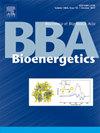用时间分辨荧光光谱法研究了紫色细菌反应中心中单体细菌叶绿素的振动冷却
IF 2.7
2区 生物学
Q2 BIOCHEMISTRY & MOLECULAR BIOLOGY
引用次数: 0
摘要
细菌、藻类和植物的光合作用始于(细菌)叶绿素分子对光能的吸收,其中一部分光能随后转化为热量,导致分子温度的短暂变化。利用皮秒荧光光谱技术研究了球形红杆菌(Rba.)反应中心(RCs)的这一现象。利用VR(L157)突变排除电荷分离过程,使我们能够记录单体BChl a分子的荧光光谱动力学。我们发现,RCs激发到Soret波段后,BChl a会被~160 K显著加热,随后进行振动冷却,这表现为BChl a荧光光谱的动态变窄,特征时间为5和16 ps。RCs激发到Qx波段时,观察到~65 K的微弱加热和特征时间为7.5 ps的冷却。在280 nm区域色氨酸的差异吸收光谱显示,观察到的BChl a荧光光谱的动态与RCs蛋白基质的介电重排无关。利用振动冷却的现象学模型对得到的数据进行分析,得出在受激BChl a的热扩散过程中,来自BChl a直接环境的几个氨基酸残基充当第一溶剂化壳层(FSS)的结论。在第一阶段,热量从BChl a传递给FSS,在第二阶段,FSS将热量传递给RCs的蛋白质基质。我们的工作表明,在研究光合作用的主要过程时,考虑振动冷却的重要性。本文章由计算机程序翻译,如有差异,请以英文原文为准。
Vibrational cooling of monomeric bacteriochlorophylls in reaction centers of purple bacteria studied by time-resolved fluorescence spectroscopy
Photosynthesis in bacteria, algae, and plants begins with the absorption of light energy by (bacterio)chlorophyll molecules, part of which is then converted into heat, leading to a transient change in molecular temperature. We investigated this phenomenon in reaction centers (RCs) of the purple bacterium Rhodobacter (Rba.) sphaeroides using picosecond fluorescence spectroscopy. Exclusion of charge separation processes using the VR(L157) mutation allowed us to record the spectral dynamics of fluorescence of monomeric BChl a molecules. We found that excitation of RCs into the Soret band results in significant heating of BChl a by ~160 K with subsequent vibrational cooling, which manifests itself in a dynamic narrowing of the BChl a fluorescence spectrum with two characteristic times of 5 and 16 ps. The weaker heating by ~65 K and cooling with a characteristic time of 7.5 ps are observed upon excitation of RCs into the Qx band. Excitation into the Qу band does not result in any noticeable heating of BChl a. Difference absorption spectroscopy of tryptophan in the 280 nm region showed that the observed dynamics of the BChl a fluorescence spectrum are not associated with the dielectric rearrangement of the RCs protein matrix. Analysis of the obtained data using the phenomenological model of vibrational cooling led to the conclusion that during heat diffusion from excited BChl a, several amino acid residues from the immediate environment of BChl a act as the first solvation shell (FSS). At the first, faster stage, heat is transferred from BChl a to FSS, and at the second stage, FSS transfers heat to the protein matrix of RCs. Our work has shown the importance of taking into account vibrational cooling when studying the primary processes of photosynthesis.
求助全文
通过发布文献求助,成功后即可免费获取论文全文。
去求助
来源期刊

Biochimica et Biophysica Acta-Bioenergetics
生物-生化与分子生物学
CiteScore
9.50
自引率
7.00%
发文量
363
审稿时长
92 days
期刊介绍:
BBA Bioenergetics covers the area of biological membranes involved in energy transfer and conversion. In particular, it focuses on the structures obtained by X-ray crystallography and other approaches, and molecular mechanisms of the components of photosynthesis, mitochondrial and bacterial respiration, oxidative phosphorylation, motility and transport. It spans applications of structural biology, molecular modeling, spectroscopy and biophysics in these systems, through bioenergetic aspects of mitochondrial biology including biomedicine aspects of energy metabolism in mitochondrial disorders, neurodegenerative diseases like Parkinson''s and Alzheimer''s, aging, diabetes and even cancer.
 求助内容:
求助内容: 应助结果提醒方式:
应助结果提醒方式:


